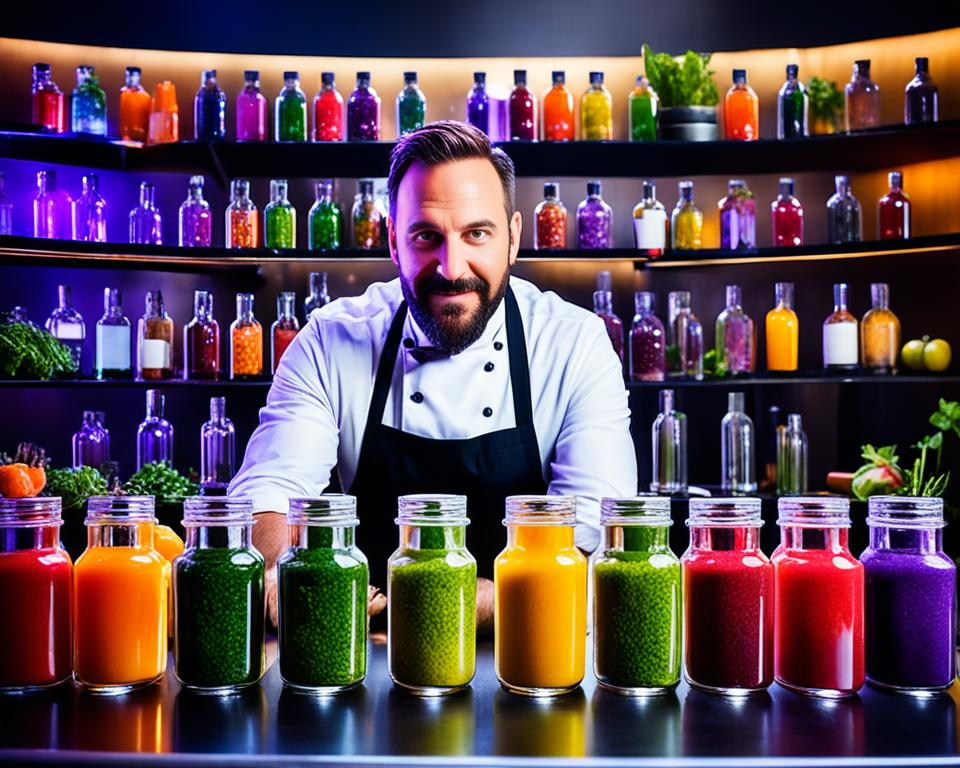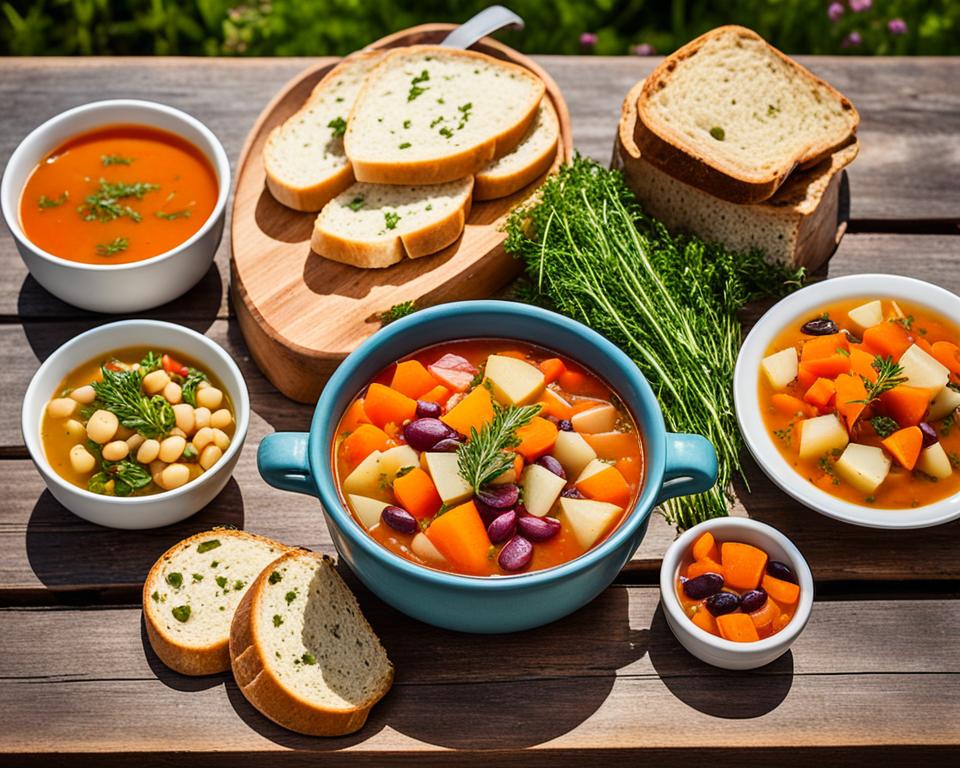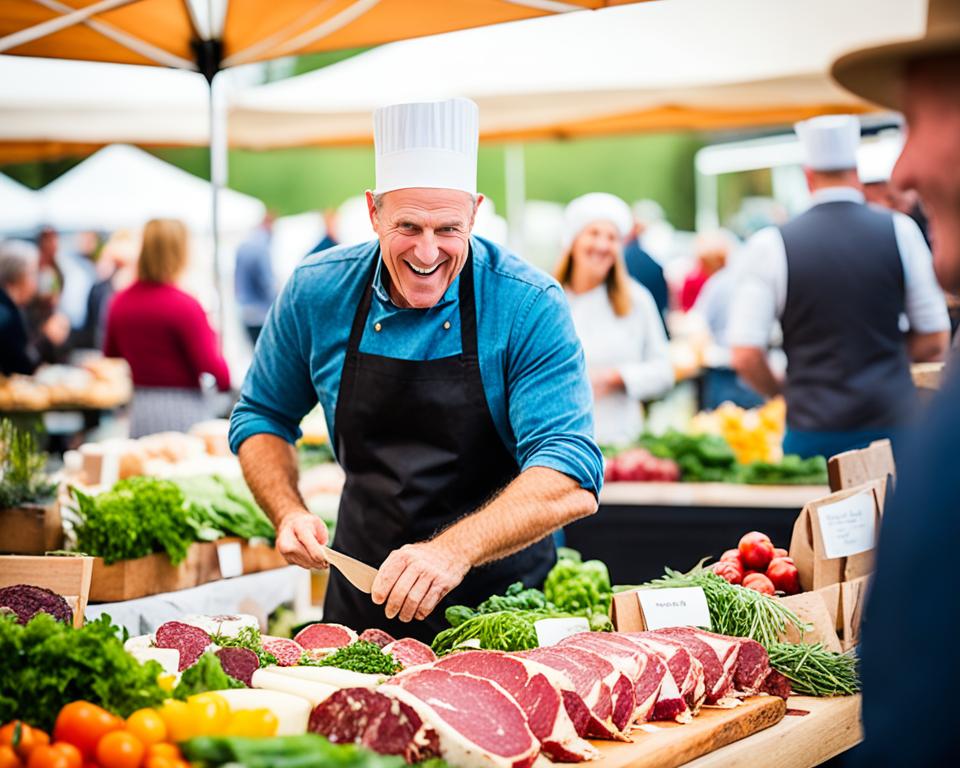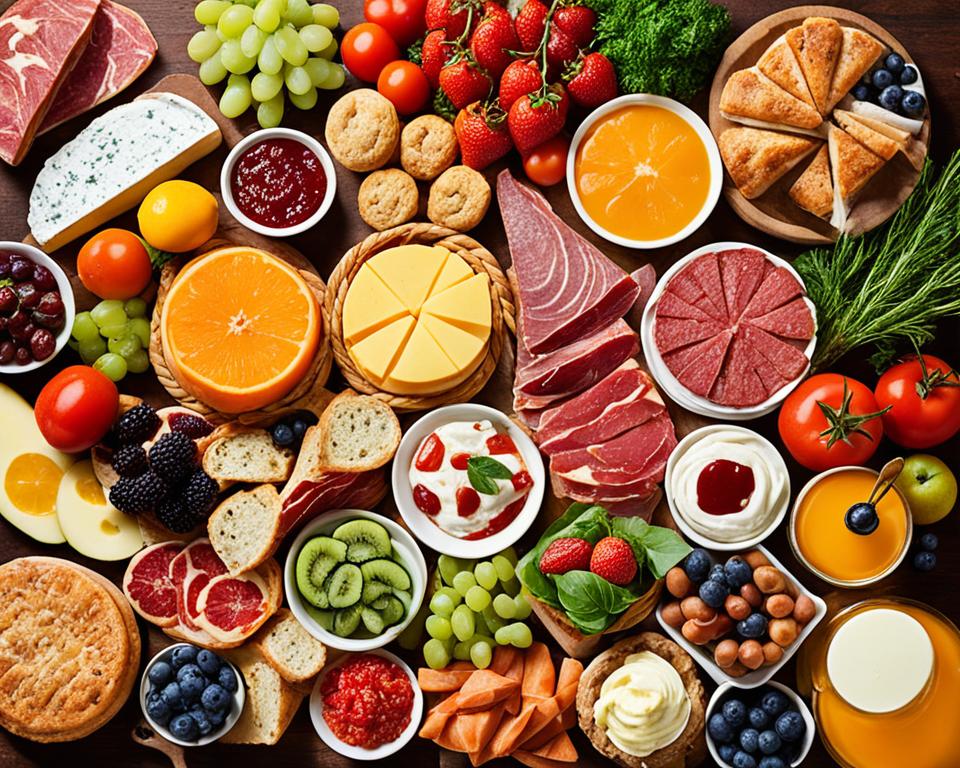Welcome to the cutting-edge of gastronomy, where we explore the latest food trends and share food industry updates that will ignite your culinary curiosity this year. As we delve into the emerging food fads, we’re discovering popular cuisine ideas that celebrate the diversity of global taste profiles and innovative cooking techniques. The 2024 food stage is set with vibrant new flavor profiles, honoring our trending dietary preferences with every bite. Eminently, our pursuit for culinary innovation continues, guiding us to embrace all that is fresh and flavorful in the world of food. Let’s unite as taste explorers and savor the delectable journey ahead, one trendsetting dish after another.
Key Takeaways
- Global flavors mark the forefront of the latest food trends, inviting us to sample the world without leaving our tables.
- Sustainability is not just a buzzword but an essential ingredient in 2024’s food industry updates, reshaping how we eat and drink.
- From third-culture cuisine to Asian ingredient highlights, we’re recognizing the rich tapestry of popular cuisine ideas.
- Innovation is the heartbeat of culinary development, with groundbreaking techniques bolstering the foundation of cutting-edge gastronomy.
- New flavor profiles emerge, paying homage to traditional tastes while propelling us towards exciting gastronomic discoveries.
- Our trending dietary preferences are being met with creativity and care, ensuring meals are as nourishing as they are delightful.
- The marriage of food and technology leads to innovative cooking techniques, making home cooking both accessible and extraordinary.
Blending Culinary Cultures: Third-Culture Cuisine Takes Center Stage
As we navigate the expansive world of culinary innovation, it becomes clear that third-culture cuisine is capturing the hearts and taste buds of food enthusiasts. Embodying a medley of global flavors, this year is about celebrating the unique cultural identities that chefs bring to the fore through their cooking. We are observing an unprecedented fusion of traditions, where dishes are not simply combined but thoughtfully amalgamated to represent the diversity and depth of our society’s intertwined roots.
Consider the rise of wafu Italian eateries, where the subtlety of Japanese aesthetics meets the robust essence of Italian cooking, or the emergence of Filipino-British bakeries which pair the sweetness of Filipino pastries with the hearty, familiar flavors of British fare. This isn’t fusion for the sake of novelty; it’s a realignment of the culinary compass to reflect our interconnected global community. Third-culture chefs are challenging the status quo by drawing on a heritage that straddles continents, using their gastronomic prowess to forge a path to new epicurean experiences.
Let’s delve deeper into how third-culture cuisine is redefining the fusion concept, demonstrating how these diverse identities shape our modern dining landscapes:
- Italian-Japanese Fusion: Wafu pasta dishes combining udon noodles with classic Italian sauces and Japanese garnishes.
- Filipino-British Confectionery: Offering an array of desserts that feature traditional British pastries with tropical Filipino fruits and jellies.
- Korean-Mexican Combinations: Tacos filled with spicy Korean beef, kimchi, and topped with creamy sauces draw on both Latino and Asian culinary heritages.
As we embrace these bold culinary expressions, we realize that it’s not just about the food—it’s about the stories behind each dish. This voyage into third-culture cuisine not only satiates our appetite for new tastes but also feeds our souls with rich narratives of cultural harmony and innovation.
“In the artful hands of today’s chefs, third-culture cuisine is more than a trend; it’s a testament to the dynamic and fluid nature of our identities expressed through the international language of food.”
| Cuisine Fusion | Signature Ingredients | Cultural Significance |
|---|---|---|
| Italian-Japanese (Wafu) | Udon, Basil, Parmesan, Miso | A delicacy that blends the precision of Japanese cooking with the warmth of Italian flavors. |
| Filipino-British | Ube, Pandan, Custard, Scone | A cross-cultural treat celebrating the Philippines’ vibrancy with British comfort. |
| Korean-Mexican | Gochujang, Tortilla, Kimchi, Cilantro | An adventurous taste venture pairing bold Korean spices with traditional Mexican preparation. |
In conclusion, our culinary journey is becoming as diverse as our collective histories. We invite you to join us as we continue to explore, learn, and most importantly—taste—the vast culinary landscapes unified under the banner of third-culture cuisine. It’s a flavorful alignment of heritage and culinary innovation, destined to reshape our palates and dining experiences for years to come.
Asian Flavors in the Spotlight: From Ube to Rambutan
As we continue to explore the richness of culinary cultures, 2024 positions Asian flavors squarely in the limelight, and we are excited to delve into the aromatic world of these delightful ingredients. Dynamic, bold, and bursting with taste, the Asian pantry brings us a plethora of ingredients that are transforming mainstream cuisine. Join us as we discover the allure of Asian fruits and the innovative twist they lend to both traditional and modern dishes.
Uncovering the Sweetness of Asian Fruits
The surge of interest in Asian fruits uncovers a world of sweetness and tang that tantalizes our taste buds. As aficionados of culinary innovation, we are eager to showcase an array of Asian fruits that elevate the sensory experience of any meal or drink. Let’s explore these exotic flavors together.
- Rambutan: With its lush, tropical sweetness, rambutan is becoming a darling of the culinary world, making its way into vibrant fruit salads and refreshing beverages.
- Pink Guava: The allure of pink guava cannot be understated. Its versatile flavor profile enhances everything from zesty salsas to elegant pastries.
- Dragon Fruit Varieties: The distinct sweetness and subtle tanginess of dragon fruit varieties, such as the golden, white, and purple, offer a palette of flavors, perfect for smoothies and exotic desserts.
Savory Snacks and Desserts with an Asian Twist
It’s not just the fruits that are drawing attention; Asian ingredients are redefining the snack and dessert landscape. Desserts laced with ube and savory treats sprinkled with black sesame are just a glimpse into the incredible versatility of these flavors. Here are some culinary delights we’ve been crafting with these ingredients:
| Ingredient | Dish Type | Flavor Profile |
|---|---|---|
| Ube | Hot Chocolate | Rich and comforting, with a hint of earthy sweetness |
| Black Sesame | Cookies | Nutty with a subtle smokiness, perfect for pairing with tea or coffee |
| Milk Tea | Popcorn | A surprising twist of creamy sweetness meets savory, a true umami experience |
These vibrant Asian influences not only enhance our culinary creations but also inspire a broader appreciation for the depth and complexity of Asian cuisine. We’re embracing this trend with open arms and an eager palate, excited to see how these flavors will continue to shape the landscape of food innovation.
“This year, more than ever, we are witnessing a flavorful revolution, as Asian fruits and ingredients infuse our meals with exquisite new dimensions of taste.”
Next Wave of Sustainability: Innovations in Food Production
The year 2024 heralds a new era of sustainability within the food industry, one brimming with inventive solutions aimed at minimizing our environmental footprint. At the heart of this eco-conscious transition are alternative chocolates, a sweet innovation minus the bitter environmental impact of conventional cocoa farming. These delectable confections embody the familiar sensory indulgence of chocolate while bypassing deforestation concerns.
As drought conditions draw new lines across agricultural landscapes, we’re turning to waterless plant milks to quench our thirst for sustainability. These innovative powdered plant milks, easily reconstituted with water, reduce our reliance on water-intensive dairy and plant milk production, significantly lowering CO2 emissions associated with transportation.
In our quest to champion eco-friendly practices, we’re embracing drought-friendly crops like the resilient prickly pear cactus. This versatile plant offers a bounty of possibilities, birthed from necessity and flourishing in arid climates, a testament to our adaptability and ingenuity in the face of climate challenges. Prickly peers are now the base for an assortment of snacks, ranging from energy-boosting trail mixes to sweet confections, all while caring for our precious environmental resources.
Let’s take a closer look at some of the emerging food fads driven by our passion for eco-centric innovation:
| Product | Description | Environmental Benefit |
|---|---|---|
| Alternative Chocolates | Chocolate-like treats crafted from ingredients such as grape seeds and legumes. | Reduces deforestation and offers a more accessible alternative to cocoa products. |
| Waterless Plant Milks | Powdered plant-based milks intended for home rehydration. | Decreases water usage in production and slashes CO2 emissions from transportation. |
| Prickly Pear Snacks | Snack items crafted from drought-friendly prickly pear cactus. | Supports the growth of crops that require minimal water resources. |
As we sample and savor the inventive outputs of this year’s food innovations, we’re not only indulging in new flavors and textures but also contributing to a food system that values sustainability as its core tenet. It is through these conscious choices and emerging trends that we set a new standard for responsible production and consumption.
Together, we set our sights on a future where every bite and every sip taken is a stride toward environmental stewardship and planetary wellness.
Fun with Fungi: Mushrooms as a Culinary Powerhouse
We’re observing an extraordinary trend that transforms the humble mushroom into a culinary powerhouse. 2024 is becoming the year of mushrooms, where their role extends beyond mere ingredients to centerpieces of innovative dishes. As a meat replacement, mushrooms have become the darling of the culinary world, and we are here for it all—every savory and earthy bite.
Mushrooms are not just thriving in the wild or farms; they’ve made their way into city homes through urban farming. Let’s dig into the myriad ways mushrooms are changing the game in our kitchens and revolutionizing innovative cooking techniques.
From Shiitake Bacon to Roasted Lion’s Mane
It starts with shiitake bacon, an umami-packed delight that sizzles alongside your morning eggs. But why stop there? Enter the majestic lion’s mane mushroom, known for its resemblance to seafood, making it an ideal candidate for creating mouthwatering dishes like mushroom crab cakes. The sheer versatility of mushrooms allows us to push the bounds of culinary innovation.
Mushrooms at Home: Urban Farming Trends
Our concrete jungles are blossoming with gourmet fungi, thanks to urban farming enthusiasts. It’s becoming increasingly common to find mushroom kits in city apartments, a nod to the growing trend of home-grown produce. Oyster, portobello, and cremini—there’s a variety for every budding urban gardener to cultivate.
| Mushroom Variety | Culinary Uses | Urban Cultivation Ease |
|---|---|---|
| Oyster Mushrooms | Pulled mushroom BBQ, stir-fries, soups | Easy – Thrives in small spaces |
| Lion’s Mane | Meatless burgers, “crab” cakes, chowders | Moderate – Requires attentive care |
| Shiitake | Bacon substitute, risottos, dumplings | Challenging – Prefers wood substrates |
The world of fungi offers us a bounty of opportunities to experiment and savor. These exciting trends make mushrooms our ally in crafting delicious, responsible, and groundbreaking culinary experiences. So let’s keep the fun with fungi going strong and make every plate a testament to the sustainability and versatility of these amazing mushrooms.
A Revival of Vegetable-Centric Menus
As we witness the dawn of 2024, we’re experiencing the budding excitement around vegetable-forward restaurants, a reflection of our trending dietary preferences. In this renaissance of plant-based cooking, vegetables are no longer a side thought but the stars of our plates, receiving imaginative culinary makovers that transform them into majestic main courses.
With a deep commitment to culinary innovation, chefs across the nation are grilling, roasting, and puréeing, elevating the humble vegetable. As pioneers in popular cuisine ideas, we’re seeing vegetables like broccoli break out of their traditional mold to become the center of culinary attention. It’s in our kitchens where a simple carrot is not just a carrot, but a canvas for creativity and a vessel for rich, natural flavors.
Our exploration into vegetable-centric cuisine is not just about giving vegetables a new twist; it’s about transforming culinary landscapes and offering diners a thrilling gastronomic journey. Together, let’s dive into a table of delicious ingenuity that pays homage to the versatility and vibrancy of vegetables:
- Char-Grilled Broccoli: A dish where the innate sweetness and slight char provide a concert of flavors, completely altering one’s perspective of the green tree-like vegetable.
- Pureed Parsnip: Once a forgotten root, now turned into a silky-smooth puree, it complements the intricate layers of refined dishes, enhancing their richness with its creamy texture.
- Hearty Vegetable Stews: Combining seasonal produce in soul-warming stews that allow each ingredient to speak and contribute to a chorus of comforting winter flavors.
It’s undeniable that vegetable-forward restaurants are seeding a prolific growth, transforming the standard expectations of dining out. Vegetables, with their natural allure and packed with nutrients, are finally receiving the culinary spotlight they deserve. Our dining tables are becoming playgrounds for plant-based culinary innovation, delighting those who seek nourishment that’s both sustainable and delicious.
“No longer humble sides, vegetables are taking over the spotlight and proving that greens can be both gratifying and gourmet.”
In a world where our choices at the table reflect our values and palates, we invite you to join hands with us in embracing this tide of vegetable-centric menus. Together, we’re not just eating; we’re participating in a movement that sows the seeds of a brighter, more flavorful future.
Latest Food Trends: Dining Experiences in a Drink
The boundary between the culinary and cocktail worlds is blurring, ushering in a new epoch of culinary integration. We find ourselves marveling at the artistry and cocktail creativity unfolding before us, as avant-garde mixologists concoct beverages that echo the complexity of a gourmet meal. With an adventurous spirit, our taste buds embark upon sensory experiences through these carefully crafted libations. Gone are the days of drinks serving merely as accompaniments; in 2024, they are pivotal characters in the narrative of dining.
Venturing Beyond Traditional Beverages: Culinary Cocktails
Imagine a cocktail that embodies an entire dining experience. Picture sipping on a concoction that prompts not just a singular taste response but a journey through a story, one sip at a time. This is the future forecasted by the wave of culinary cocktails, a testament to our relentless pursuit of food trends that defy convention. These beverages are crafted with care, incorporating unexpected ingredients like honeysuckle syrup, charred tomato shrub, and infused salts—each adding a dramatic flare to the symphony of flavors within our glass.
Culinary Cocktails as Sensory Journeys
Our appreciation for new flavor profiles is heightened as we delve into drinks that encapsulate the essence of an elaborate meal. The intrigue of a savory cocktail garnished with a sprig of rosemary, a slice of char-grilled peach, or a drizzle of artisanal olive oil creates a moment that is as visually stunning as it is flavorful. Each glass is an exploration, a tangible incarnation of taste presented with an artful finesse that transforms the act of drinking into a kinetic art piece, stimulating every sense in a symphony orchestrated for pleasure.

In essence, as we journey through the year 2024, we witness a culinary metamorphosis where beverages are not merely quenchers of thirst but raconteurs of flavor. They invite us on an olfactory voyage, weaving narratives of spice and sweetness, of earth and air, reminding us that every sip is an opportunity for discovery and delight. We raise our glasses to the artisans of cocktail creativity, to the alchemists who make our dining experiences not just memorable but revolutionary.
“These libations are not mere drinks; they are vivid stories told in hues of amber and gold, savored one poetic sip at a time, unraveling the secrets of flavor and passion.”
Mindful Drinking and the Rise of Sophisticated Non-Alcoholic Options
As we navigate the ever-evolving landscape of trending dietary preferences, we’re elated to see the concept of mindful drinking gaining traction. In 2024, sophisticated non-alcoholic options are elegantly pouring into mainstream consciousness, enabling a seamless integration of inclusivity into our social and dining rituals. It’s a movement buoyed by the pursuit of balance and an enlightened perspective on consumption.
Our discerning drinkers, who once faced a binary choice in beverage selection, now revel in the vibrant terrain of “substituters”—a term we’ve affectionately coined for those who oscillate between non-alcoholic and alcoholic sophisticated beverages with ease and finesse. It’s a reflection of our society’s growing embrace of flexibility and wellness without sacrificing the essence of celebration or camaraderie.
In this new age of beverage enlightenment, non-alcoholic cocktails are not just imitations of their spirited counterparts; they are original creations, thoughtfully crafted to stand proudly in their own right. To illustrate this, we’ve seen, savored, and been inspired by the transformative emergence of non-alcoholic wines. These libations are intricately layered with complex teas and botanical extracts, weaving a rich tapestry of flavor that competes with, and sometimes even surpasses, traditional wines.
“The art of mindful drinking is not just about abstinence; it’s about making choices that align with our individual values and contexts, all while enjoying the journey of taste exploration.”
Behold the tableau of our curated non-alcoholic symphony:
| Non-Alcoholic Beverage | Key Ingredients | Taste Experience |
|---|---|---|
| Mocktail Margarita | Fresh Lime Juice, Seedlip Spice, Agave Syrup | A zesty union of sweetness and spice, bringing the essence of a margarita to life sans alcohol. |
| Tea-Infused Faux Wine | Hibiscus Tea, Verjus, Berry Extracts | Delightfully tangy with underlying fruit notes, echoing a bold red varietal. |
| Herbal Elixir | Chamomile, Lemon Balm, Honey | A serene sipper that calms with every cup, reminiscent of a delicate aperitif. |
As advocates for this burgeoning trend, we wholeheartedly invite our readers to indulge in the allure and nuance of mindful drinking. It is within these cultivated experiences that we find both innovation and tradition blending harmoniously. Whether you’re raising a toast with a sparkling tonic or sipping on a robust non-alcoholic stout, each beverage is a testament to the expansive potential that mindful drinking has unfurled.
Together, let’s continue to celebrate and shape the future of mindful drinking, fostering environments where every preference is respected and every pour is thoughtfully considered. After all, we believe that the essence of a great beverage lies not in its alcohol content but in the quality of its ingredients, the expertise of its crafting, and the joy it brings to our shared moments.
Funky Flavors, Unusual Ingredients, and Bold Colors
Welcome to the vibrant evolution of our gastronomic tapestry in 2024, where culinary innovation and cutting-edge gastronomy push the boundaries of creativity. Our palates are enticed by unexpected taste sensations, bringing to light an array of funky flavors, unusual ingredients, and bold colors that transform eating into an art form. In this section, we explore how these trends are making waves in the food industry and why it’s more than just a feast for the taste buds—it’s a visual spectacle too.
Snacks and Chips with a Global Palette
Our journey through the latest food fancies takes us to the realm of savory snacks where conventional chips no longer suffice. Brands like Lay’s have redefined the chip game with flavors that whisk us away to international culinary landscapes, such as the captivating “numb & spicy hot pot” that has enthusiasts craving more.
| Flavor | Inspiration | Potato Chip Transformation |
|---|---|---|
| Numb & Spicy Hot Pot | Sichuan Cuisine | Combining the heat of chilies and numbing Sichuan peppercorns to replicate the beloved hot pot experience. |
| Roasted Cumin Lamb Skewer | Chinese Street Food | Chips seasoned with earthy cumin and aromatic spices, mirroring the flavorsome grilled lamb skewers. |
| Jamon (Spanish Ham) | Spanish Delicacy | Crispy layers of chips infused with the savory and slightly sweet nuances of jamon. |
This explosion of global flavors on our snack shelves is not just about tasting the world, but bringing into our living rooms the essence of far-off cuisines.
Iridescent Pasta and the Fascination with Food Color
The tapestry of 2024’s food scene isn’t complete without the splash of bold colors that have begun to permeate even the most traditional of foods. Artisan pasta takes a dive into the deep end of the color wheel, now presented in hues ranging from the mystical black of squid ink to the elusive truffle-infused tinges that tickle both the visual and flavor palette.
Our enamorment with bold colors in cuisine is perfectly captured by the enthusiasm for blue-toned foods. Influences from the serene blues of our oceans and skies find their way into our culinary concoctions, delivering not just a visual impact but also a tranquil reminder of nature’s palette. From the butterfly pea-tinted muffin to the algae-colored smoothie, every bite is a nibble into the picturesque views of our planet.
Indeed, as we dine, we indulge in a canvas of colors and tastes where the aesthetics amplify the appeal, and every dish is a masterpiece worthy of admiration.
“In the theatrics of dining, color plays a leading role, turning every meal into a celebration of the vibrant art that is cooking.”
Embracing Humble Origins: The Return of Classical and Frugal Foods
As we delve into the current year, classical foods and frugal ingredients are undergoing a remarkable renaissance. In 2024, the culinary scene is taking a nostalgic turn, with both chefs and consumers alike discovering the inherent beauty and resourcefulness in simplicity. The revival of traditional recipes and utilitarian ingredients marks a poignant celebration of culinary innovation, woven into the very fabric of popular cuisine ideas. Driven by economic sensibilities and an earnest appreciation for the past, we are rekindling our love affair with the understated elegance found within our gastronomic heritage.

Our journey back to the basics is not one of mere regression but of thoughtful progression. By infusing time-honored cooking techniques with contemporary twists, we are able to achieve a sophisticated balance that respects the environment while tantalizing the palate. We’ve seen a wave of inspired creations that shine a light on the remarkable versatility of humble staples such as lentils, rice, and seasonal vegetables.
- Bean casseroles, manifesting as both heartwarming and nutritious, adorn our dinner tables with a comforting embrace.
- Root vegetables, once the unsung heroes of the produce world, now feature prominently in gourmet dishes, dazzling with their earthy flavors.
- Grains, the steadfast foundation of many a meal, are being reinvented—transforming simple rice porridge into an elevated dish through inventive use of spices and farm-fresh toppings.
Let’s reflect upon how these frugal yet fascinating foods are carving their place in the realm of gastronomy:
| Ingredient | Culinary Application | Example of Innovation |
|---|---|---|
| Beans | Protein-rich base for stews and soups | Fava bean stew with artisanal sourdough |
| Root Vegetables | Roasted, mashed, or in salads | Caramelized parsnip soup with a swirl of truffle oil |
| Grains | Porridges, pilafs, and grain bowls | Barley risotto with wild mushrooms and thyme |
“We’re rekindling our relationship with the dishes of yesteryear, crafting elegant plates that speak to our roots while presenting a feast for the senses.”
In this changing culinary landscape, we embrace a movement that not only harkens to our past but endeavors to secure a sustainable and sumptuous future. Join us in celebrating the unwavering presence of classical foods and the modest majesty of frugal ingredients, as we toast to the timeless art of cooking with a thoughtful eye towards ingenuity and taste.
Engaging with Worldly Whiskies and Homemade Spirits
The spirits universe is expanding, and we find ourselves at the heart of a global movement celebrating the diversity of worldly whiskies and the craft of homemade spirits. From hidden distilleries nestled in the verdant valleys of New Zealand to the historic stills of Scotland, our quest for distinctive flavors leads us to global selections that redefine the traditional whisky narrative. Hand-in-hand with this exploration of global spirits is a burgeoning trend: the art of distilling personalized spirits at home, reflecting a deepening connection between self-expression and spirits.
Diversifying the Whisky Scene with Global Selections
As seasoned explorers in the realm of fine spirits, we have witnessed the allure of exceptionally crafted whiskies that hail from the most unexpected corners of the world. This expansion in the whisky world breaks the mold, bringing forward a rich tapestry of tastes that promise a sensorial voyage with every sip. From the peaty notes of Tasmanian whisky to the mellow complexities found in whiskies from Taiwan, our palates are treated to a world tour underpinned by unparalleled craftsmanship and innovative cooking techniques.
| Whisky Origin | Tasting Notes | Distinctive Qualities |
|---|---|---|
| Tasmania | Deep peat smoke, apple undertones | Local barley and unique distillation methods |
| Taiwan | Tropical fruit, vanilla, subtlety of oak | Age-accelerating subtropical climate |
| Sweden | Spicy notes, herbaceous finish | Use of frozen filtered water for purity |
Home-brew Endeavors: Making Spirits Personal
In our kitchens and basements, the magic of distillation transforms, allowing spirits lovers to create homemade spirits that tell their own story. These home-brew ventures span the gamut from small pot stills producing vibrant gins to oak-cask aged whiskies that carry the signature of their creator. Far more than a hobby, this practice of personal distilling is about curating a collection of spirits infused with individuality and the hands-on application of innovative cooking techniques.
We revel in the joy of crafting and sipping on spirits that resonate with our narrative, as every homemade bottle encapsulates a unique journey from grain to glass.
From Fine Dining to Retail: Restaurants as Brand Ambassadors
Within the dynamic world of gastronomy, an intriguing trend has emerged where the realms of fine dining seamlessly integrate with retail spaces. We are witnessing an era where esteemed restaurants transform into brand ambassadors, offering patrons the opportunity to bring a piece of the dining experience into their homes. This harmonious blend of culinary innovation and marketing ingenuity propels restaurant-branded products onto the shelves of our local grocers, thereby extending the sensory delights of lavish eateries into our daily lives.
It’s not just about slathering a sauce onto a dish anymore; it’s about encapsulating the essence of a chef’s culinary vision into a bottle. Picture the complexity of a Michelin-starred sauce that once graced your plate at a renowned establishment now available in the comfort of your kitchen. These ventures reflect the creativity and passion of chefs eager to share their artistry beyond the constraints of their restaurants. This strategic move not only enhances brand visibility but also presents a novel revenue stream, crucial in today’s competitive food industry.
Let us explore a tableau showcasing the transition from fine dining to accessible, at-home indulgences:
| Restaurant | Signature Product | Impact on Retail |
|---|---|---|
| Gourmet Bistro | Truffle-infused Honey | Elevates gourmet pantries with a taste of luxury |
| Seafood Haven | Aged Miso Soy Glaze | Brings intricate seafood flavors to home cooking |
| Italian Ristorante | Hand-crafted Tomato Basil Sauce | Delivers authentic Italian cuisine to home dining |
These branded creations are not a fleeting gimmick; rather, they are a profound expression of a restaurant’s identity. As we delve into these products, we are, in essence, engaging with the story and legacy of their origin. Restaurants, with their renowned culinary innovation, are now accessible in ways we once only dreamed of—inviting us to taste, experiment, and even recreate signature dishes that have defined our most cherished dining moments.
“Our kitchens have become extensions of the world’s finest restaurants, and with each dish we prepare using restaurant-branded products, we partake in an unseen symphony of fine dining excellence.”
As we stand witness to this delicious evolution, our role is not just that of consumers but of culinary adventurers who now hold the key to unlocking the treasure chest of fine dining secrets. Together, we eagerly anticipate the continued growth of this trend, where restaurants as brand ambassadors captivate, educate, and inspire us within the ever-expanding universe of epicurean delight.
Beans: An Affordable Protein Source in Gourmet Dishes
Witness the transformation as beans emerge from their humble roots to grace the tables of high-end eateries, showcasing sustainability and rich nourishment wrapped in gourmet beguilement. This renaissance celebrates beans not only as an affordable protein but as the star of an innovative culinary drama where flavor and eco-consciousness play leading roles.
Sustainability Meets Nutrition: Beans’ Renaissance
In the realm of contemporary cuisine, we’ve seen the reemergence of beans, recognized now for their environmental and nutritional benefits. These versatile legumes embrace our quest for sustainability, offering a high-protein yield with a low carbon footprint. Their ability to enrich the soil with nitrogen further positions them as a champion of ecological farming practices.
Our culinary chronicles of 2024 reveal beans in a new light: a symbol of conscious consumption and an ally in our pursuit of planetary well-being.
Culinary creativity finds fertile ground in the humble bean, inviting us to partake in dishes that nourish the body while, indeed, stewarding the earth.
Beans on the Menu: Creative Culinary Approaches
With an ever-expanding repertoire, beans have vaulted from simple sides to centerpiece attractions in gourmet dishes. Our explorations unveil that, through culinary creativity, these beans are embarking on a journey into gourmet stratospheres, impressing the most discerning palates with their adaptability and robust textures.
Gone are the days when beans played a mere supporting role. Enter the era where every type of bean, from the creamy cannellini to the hearty black bean, receives a chef’s touch, morphing into extravaganzas of flavor. We’re enjoying them in slow-cooked cassoulets, as velvety purees beside artisanal cuts of meat, or even starring in their own right as the base for avant-garde burger patties.
| Bean Variety | Gourmet Dish | Description |
|---|---|---|
| Black Turtle Beans | Charred Bean Tacos | A smokey twist on Mexican cuisine, these tacos bring deep flavors and satisfying textures to the table. |
| Gardez Beans | Fines Herbes Salad | Fresh, herbaceous, and imbued with the lightness of the garden, this dish honors the bean’s natural flavors. |
| Navy Beans | Truffle-Infused Bean Dip | Rich, earthy, and sophisticated, this dip elevates the navy bean to new, luxurious heights. |

As we glance into the future of food, we acknowledge how beans have broken free from their rudimentary role and now dance among the delicacies of fine dining. Together, we revel in this chapter where beans, the epitome of affordable protein and sustainability, are rediscovered and reimagined, exalted by chefs eager to push the envelope of gastronomy.
Conclusion
As we reflect on the rich tapestry of 2024’s latest food trends, it’s evident that we’ve embarked on an exhilarating escapade through global palates and innovative flavors. This year has been a mosaic of emerging food fads, each piece a testament to our pursuit of authenticity and culinary craftsmanship. From the playful ingenuity of fungi feasts to the modern allure of third-culture cuisine, we’ve seen an inspiring array of innovative cooking techniques and popular cuisine ideas. These discoveries have not only delighted our taste buds but have also illuminated the creative potential within the culinary domain.
Our journey together through 2024 has unveiled a parade of palatable delights deeply rooted in trending dietary preferences, showcasing a collective desire for diversity and sustainability on our plates. It’s been a year where beverages are not mere sippers but storytellers, non-alcoholic brews mirror the complexity of their spirited kin, and time-honored classics are reinvented with a contemporary twist. Every sip and every bite has afforded us moments of joy and reflection, hand-in-hand with our evolving ethos towards health and the environment.
In sum, as we draw the curtains on this year’s culinary saga, we cheer the fluidity and vibrancy of the ever-changing food scene. Let us continue to celebrate the myriad flavors and textures that 2024 has bestowed upon us, embracing each meal as an opportunity for exploration and each dining experience as a symphony of taste. Here’s to savoring the ingenuity and brilliance of this year’s gastronomic glory, ever eager to taste what the future holds in the enthralling world of food and drink.
FAQ
What defines the latest food trends for 2024?
The latest food trends for 2024 are characterized by a demand for authenticity, increased sustainability, and a passion for global flavors. Culinary innovation is at the forefront, with food industry updates reflecting a mix of cultural heritages, popular cuisine ideas with new flavor profiles, and trending dietary preferences. Factors like third-culture cuisine and cutting-edge gastronomy play significant roles in shaping our dining and cooking experiences.
How is third-culture cuisine influencing the food industry?
Third-culture cuisine is a burgeoning trend in the culinary innovation space, where chefs blend their unique cultural identities with global flavors to create distinctive dining experiences. It celebrates the fusion of different culinary practices resulting in innovative dishes that reshape our understanding of fusion cuisine.
Why are Asian flavors trending in 2024?
Asian flavors are gaining popularity due to their rich and diverse taste profiles. With ingredients like ube, rambutan, and various dragon fruit varieties, consumers and chefs are attracted to the novelty and palate-expanding potential offered by these tastes. Not only are they featured in traditional dishes, but also incorporated into a vast array of savory snacks, desserts, and culinary creations.
What sustainability innovations are emerging in food production?
Sustainability is a major focus in the food industry, with innovations such as alternative chocolates that don’t rely on cocoa and waterless plant milks to help conserve resources. There is also a growing interest in drought-friendly crops like prickly pear cactus, which enable more eco-conscious consumption and promote biodiversity.
How are mushrooms featured in the latest culinary trends?
Mushrooms are being acknowledged as a versatile and sustainable meat replacement, fitting seamlessly into a variety of dishes. They’re being transformed into mouthwatering options like shiitake bacon and mushroom meatballs. Urban farming of mushrooms is also a hot topic, underscoring their appeal as an easily cultivated food source for city residents.
What’s the role of vegetables in latest menu trends?
Vegetables are enjoying a renaissance, taking center stage in many dishes as chefs discover innovative cooking techniques to highlight their flavors. Vegetable-forward restaurants are gaining traction, with menus that spotlight plants in ways that are both delicious and creative, altering perceptions of these nutritious foods.
How are cocktails evolving in 2024’s culinary scene?
Cocktails in 2024 are not just about the drink itself, but the overall dining experience. Culinary integration has led to beverage creations that feature food-related elements, crafting multisensory experiences that combine new flavor profiles with texture and aroma, like never before.
What is the importance of non-alcoholic beverages?
The trend of mindful drinking has brought about a rise in sophisticated non-alcoholic options that provide complexity and enjoyment akin to their alcoholic counterparts. This supports a lifestyle where consumers can choose when to indulge in alcohol and when to opt for a non-alcoholic yet equally refined alternative.
Are there any new flavor or color trends in snacks and dishes?
Definitely! We’re seeing a surge in funky flavors and bold colors in the food scene. For instance, snacks are taking on globally inspired tastes like “numb & spicy hot pot” flavors. Colors such as blue are making a statement in dishes, bringing visual excitement to the plate along with unique taste experiences.
How are classical and frugal foods being reimagined in 2024?
With a nod to tradition and an eye on sustainability, frugal foods and classical dishes are being reinterpreted by chefs aiming to create simple yet sophisticated flavors. This reflects a respect for ingredients and the desire to make high-quality food accessible, regardless of economic conditions.
What’s happening in the world of whisky and spirits?
The global whisky scene is expanding, with distillers from around the world entering the market and bringing a variety of flavors influenced by their local terroirs. At the same time, there’s a growing interest in home distilling, where enthusiasts can create personalized spirits, demonstrating a hands-on engagement with beverage crafting.
How are restaurants extending their brand into retail products?
Restaurants are leveraging their culinary expertise by offering their signature sauces and condiments in retail formats. This move allows customers to experience Michelin-level flavors at home and provides restaurants with new revenue streams, blending the lines between fine dining and everyday consumer products.
Why have beans become a highlight in gourmet cuisine?
Beans are emerging as a sustainable and affordable protein source that’s winning their place in high-end culinary dishes. Chefs are creatively using beans to showcase their versatility and nutritional value, presenting them both as luxury ingredients and viable alternatives to meat.





